

Chichén Itzá, one of the best-known archaeological sites of the Maya civilization, has a split personality. The site is located in the northern Yucatan peninsula of Mexico, about 90 miles from the coast. The south half of the site, called Old Chichén, was constructed beginning around the year 700, by Maya emigres from the Puuc region of southern Yucatan. The Itzá built temples and palaces at Chichén Itzá including the Red House (Casa Colorada) and the Nunnery (Casa de las Monjas). The Toltec component of Chichén Itzá arrived from Tula and their influence can be seen in the the Osario (the High Priest's Grave), and the Eagle and Jaguar Platforms. Most interestingly, a cosmopolitan blending of the two created the Observatory (the Caracol) and the Temple of the Warriors. Photographers for this project include Jim Gateley, Ben Smith, Dolan Halbrook, Oscar Anton, and Leonardo Palotta This little building is an exemplary form of a Puuc (pronounced "pook") house. Puuc is the name of the hill country in the Yucatan peninsula of Mexico, and their homeland included the big centers of Uxmal, Kabah, Labna, and Sayil. The Puuc style of architecture consisted of veneer stones cemented in place over a rubble core, stone roofs with corbeled vaulting and intricately detailed facades in geometric and mosaic stone veneers. The smaller structures have plain plastered lower elements combined with an intricate roof comb—that's the free-standing tiara on the top of the building, seen here with a lattice crust mosaic. The roof design in this structure has two Chac masks looking out. Chac is the name of the Maya Rain God, one of the dedicatory gods of Chichén Itzá.
| 1 | Location | : | Yucatán, Mexico | ||
|---|---|---|---|---|---|
| 2 | Region | : | Yucatán | ||
| 3 | Culture | : | Maya civilization | ||
| 4 | Length | : | 270 meters (885 feet) | ||
| 5 | Height | : | 98 feet | ||
| 6 | Width | : | 181 feet wide |

The Christ the Redeemer statue in Brazil is iconic. Sitting atop Corcovado mountain and overlooking the city of Rio de Janeiro, it is a statue known around the world..
Read More